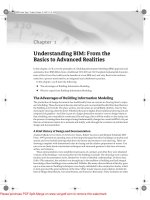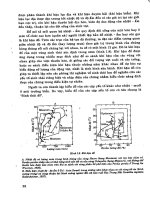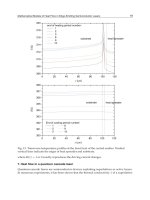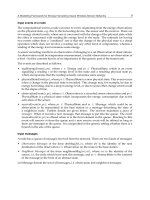Steel Structure Design Part 2 ppt
Bạn đang xem bản rút gọn của tài liệu. Xem và tải ngay bản đầy đủ của tài liệu tại đây (353.84 KB, 11 trang )
Steel = 98% of Iron with Main Alloying
Steel = 98% of Iron with Main Alloying
Elements Carbon, Silicon, Manganese
Elements Carbon, Silicon, Manganese
•Copper and chromium added to increase corrosion resistant
•Rarely contains more than 0.25% of carbon
•Higher the carbon content, the brittle the steel
•Grade 43 ( most common ), 50 and 55 (strongest)
•Design Grade -> Thickness -> Design Strength
•Hot Formed and Cold Formed Hollow Sections
•Ductile at temperature above 10 degree C and more
brittle as temperature falls below that.
•Performs badly in fires, with strength decreases with
rise in temperature.
•Fire protection is needed such as encasing steel
member with concrete.
•Exposed steelwork easily subjected to corrosion.
•For corrosion protection, use :
•Metallic coating - dipping in a bath of molten zinc in
galvanizing process or
•- spray on coating of aluminium or zinc is used on
the member
•Painting - primer of zinc chromate followed by coats
of iron oxide
•Grade 275 series steel for all members
•All steel area to be painted shall be primed with a coat
of red lead primer or 1 coat of zinc chromate primer
•All steel purlins and all steel members for building 5
storey and above shall be hot dipped galvanized
•All bolts, nuts and washers for connecting purlins and
for building 5 storey and above shall be zinc-
electroplated
CONNECTIONS
•BS 5950 mentioned “Connections should be
designed on the basis of a realistic assumption of
the distribution of internal forces,having regard to
relative stiffness”
•Joint should be designed to act in accordance with
the assumptions already made in the design
•Ductility of steel assists in the distribution of force
generated within a joint
•Means that not a need to consider residual forces
due to lack of fit, or bolt tightening
•Rigid Design
•Joints in structure are assumed to be able to fully
transfer the forces and moments in members which
they attach
•Semi-Rigid Design
•Joints in structure are assumed to transmit some restraint
moment
•Not recommended as the design concept is not matured
enough for practical design use
•Simple Design
•Pinned joints, and significant moments are not developed at
connections
•Beams are designed as simple supported
•Simple Construction
BOLTS
Type of Bolt Abbreviation Standards
Black Bolt Black Bolt BS4190
High Strength
Bolt
HS Bolt BS3692
High Strength
Friction Grip
Bolt
HSFG Bolt BS4604









